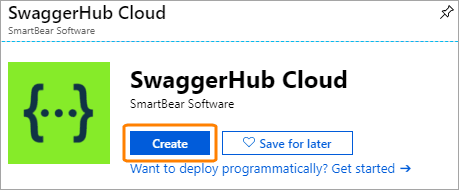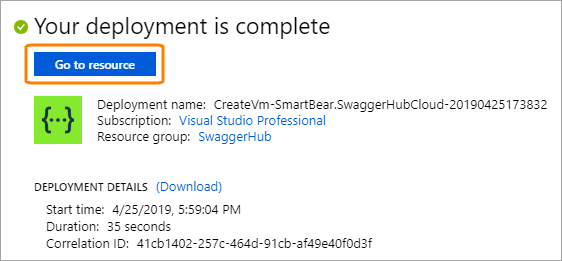SwaggerHub On-Premise is available in the Azure Marketplace, so that you can quickly deploy SwaggerHub to the Azure cloud.
Prerequisites
To deploy SwaggerHub On-Premise to Azure you need:
-
A Microsoft Azure subscription. You can sign up at https://azure.microsoft.com.
Tip: An Azure subscription is also included in the Visual Studio subscription and some other Microsoft subscriptions. -
An SSH key pair.
-
A SwaggerHub license file provided by a SmartBear representative. To request a free trial license, please fill out this form:
Create a SwaggerHub On-Premise virtual machine
-
In the Azure portal sidebar, click Create a resource.
-
Search for swaggerhub and select SwaggerHub Cloud in the search results.
-
Click Create.

-
On the Basics page, specify the following options:
Option Value Subscription Select your Azure subscription Resource group Click Create new and specify SwaggerHub as the resource group name. A resource group is a logical container that holds related resources for deployment. Virtual machine name Enter a name for your SwaggerHub VM Region Select the Azure region to deploy the VM to Availability options Optional – select if needed Image Leave as is Size The recommended VM size is E2s_v3 (selected by default), but you can use a different size if you wish. The selected VM size must have at least 2 VCPUs and at least 16 GB of memory. Authentication type SSH public key Username Enter a username for SSH access to your SwaggerHub VM. Note: The administrator username for the SwaggerHub application will be configured later during initial SwaggerHub configuration. SSH public key Paste your SSH public key -
Click Next : Disks.
-
Leave all the options as is and click Next : Networking.
-
Specify the networking options:
Option Value Virtual network and Subnet Select the virtual network and subnet where the VM must be deployed, or create new ones. Public IP Azure automatically assigns a public IP address to the VM so that the VM can be accessed from the Internet. The IP address is dynamic by default. If you want a static IP, click Create new and change Assignment to Static. NIC network security group Leave as is. SwaggerHub VM image has preconfigured network security rules. Configure network security group Leave as is Accelerated networking Leave as is Load Balancing Select No. If you wish to set up a load balancer for SSL termination, you can do this later. -
Click Next : Management.
-
Specify the following options:
Option Value Boot diagnostics Optional – select if needed OS guest diagnostics Optional – select if needed Diagnostics storage account If you enabled boot diagnostics or OS guest diagnostics, select the storage account for diagnostic data System assigned managed identity Off Enable auto-shutdown Off -
Click Review + create, then Create.
-
Wait until the VM is deployed. This may take a few minutes. You can track the deployment status via the notifications menu.
-
After the VM has been deployed, click Go to resource.

-
Note down the public IP address of the VM.
Configure SwaggerHub
-
Navigate to
http://<VM_IP>/uito access the installer. -
Configure the basic system settings, including the admin username and password.

If you have already configured a DNS name for the SwaggerHub VM, specify it in the DNS name for this instance option. Otherwise, specify the VM IP address in that option. -
Log in to the SwaggerHub Admin Center using the created admin user. Here you can configure additional system settings, such as single sign-on, HTTPS, and others.
After configuring the settings, you can access the SwaggerHub application at http://DNS_or_IP, and the SwaggerHub Admin Center at http://DNS_or_IP/ui.
You can also connect to the VM via SSH using the SSH user and key pair you specified when creating the VM.
Start using SwaggerHub
See Also
Re-installing SwaggerHub On-Premise 1.x
Configuring SwaggerHub On-Premise



